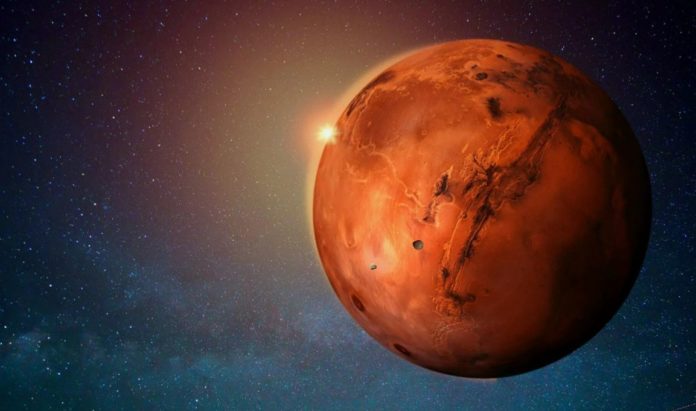A team of scientists affiliated with the European Space Agency (ESA) managed to understand how a strange elongated Martian cloud forms. This meteorological phenomenon appears annually around the southern solstice of Mars and disappears in a matter of two and a half hours.
The researchers have just published an impressive photo of the 1,800 km long cloud taken by the Visual Monitoring Camera – VMC – installed on the Mars Express spacecraft.
- Scientists in Fear of This New Predator From Red Sea Eating Native Species in Mediterranean
- Does This Mean We Stopped Being Animal and Started Being Human Due to ‘Copy Paste’ Errors?
- The One Lifestyle Choice That Could Reduce Your Heart Disease Risk By More Than 22%
- Aging: This Is What Happens Inside Your Body Right After Exercise
- Immune-Boosting Drink that Mimics Fasting to Reduce Fat – Scientists ‘Were Surprised’ By New Findings
The tubular cloud forms and fades daily, repeating the cycle for about 80 days or more within the Martian year, which lasts for about 687 Earth days. It stretches from the Arsia Mons volcano to the Olympus Mons.
While the VMC has a typical resolution for web cameras from the early 2000s, it was able to take unprecedented and detailed snapshots thanks to its wide field of view. Jorge Hernández Bernal, a doctoral student at the University of the Basque Country, stressed how “magnificent” it is to follow the evolution of a cloud in both a long and short period of time.
“As a result, we could study the whole cloud across numerous life cycles”
he wrote in the note quoted by the ZME Science portal.
The VMC images were then compared with data that was collected by other space missions, including NASA’s MAVEN probe, on dust storms and cloud movements in the Martian atmosphere.
Once that information was combined, it was discovered that it was an “orographic” phenomenon or the so-called lee cloud, which means that it is formed when the atmosphere is pushed up by air flows from surfaces, for example, mountainous. And in the case of Mars, it is the high altitude volcanoes with a leeward slope that move it.
When the humid air rises up the side of the volcano before dawn, it ends up condensing higher up in the atmosphere, where it is much colder. Meanwhile, high altitude winds move the cloud west after it reaches its maximum extent. The phenomenon lasts in total about two and a half hours.
Although Orographic clouds can be observed frequently on Earth, they do not reach such a length or show such a fast dynamics of life, explains Agustín Sánchez-Lavega, a scientist from the same teaching entity and leader of the VMC.
- Scientists in Fear of This New Predator From Red Sea Eating Native Species in Mediterranean
- Does This Mean We Stopped Being Animal and Started Being Human Due to ‘Copy Paste’ Errors?
- The One Lifestyle Choice That Could Reduce Your Heart Disease Risk By More Than 22%
- Aging: This Is What Happens Inside Your Body Right After Exercise
- Immune-Boosting Drink that Mimics Fasting to Reduce Fat – Scientists ‘Were Surprised’ By New Findings
“Understanding this cloud gives us the exciting opportunity to try to reproduce its formation with models (…) that will improve our understanding of climate systems on both Mars and Earth,” he concluded.
